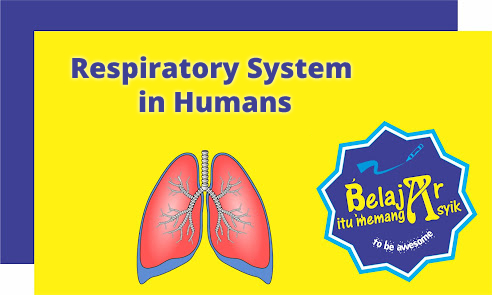The respiratory system in humans is a system of organs that support the intake and release of air (oxygen and carbon dioxide) in the body. The purpose of the respiratory system is to provide oxygen. As a raw material for the body’s metabolism in an effort to produce energy for daily activities.
Our body needs OXYGEN (O2) that we breathe every time to perform aerobic respiration. This oxygen in the cell will react with food (glucose) to produce energy (ATP), carbon dioxide (CO2) and water vapor (H2O). The reaction is as follows:

A. Types of Breathing
The types of breathing are divided into 3:
- External Breathing: The process of exchanging air (oxygen enters and carbon dioxide exits). From the outside to the respiratory organs and into the blood vessels through the alveoli in the lungs. Divided into two phases, inspiration and expiration.
- Internal Breathing: The process of exchanging air from blood vessels to cells (oxygen enters the cell) and vice versa (carbon dioxide exits the cell).
- Cellular Breathing: The process of breathing in the organelles of living organisms. In the cytoplasm and also in the mitochondria to produce energy (ATP).
B. Respiratory Organs
Respiratory System organs in humans are composed by a series of organs as follows:
1. Nasal Cavity
Although humans can breathe through the oral cavity, the main respiratory organ for inhaling and exhaling air is through the nasal cavity.
In the nasal cavity there are:
a. Olfactory nerve: functions as a sense of smell to transmit chemical information to the brain about the odors around us
b. Mucous membranes: function to keep the air moist in the nose as well as blocking the entry of harmful foreign substances or disease-causing pathogens
c. Nose hair: functions to filter dirt and dust that may enter the nasal cavity when we breathe air.
d. Sinus cavities: to warm/moisturize the inhaled air, help regulate intranasal pressure, play a role in body defense, lighten the skull and provide voice resonance.
2. Pharynx
Is a channel that connects between the nasal cavity to the throat. It consists of 3 main parts and there is an epiglottis valve that can close the airway when we swallow food.
3. Pharynx (larynx)
Is the initial part of the throat. In the larynx there are vocal cords that help us to speak. In males the larynx is larger and sticks out known as the Adam’s apple.
4. Tenggorokan (Trakea)
Is a channel that is protected by a ring-shaped cartilage. In the inner epithelial layer there are cilia to filter air. If dirt enters the throat, the cilia will vibrate and coughing occurs.
5. Throat branches (Bronchi)
The trachea will branch into the right and left lungs and then each branch will branch several times to the smallest branching.
6. Lungs (Pulmo)
Although a pair, the right and left lungs have different characteristics. For example, the typical adult left lung weighs about 325–550 grams and the right lung weighs about 375–600 grams.
For anatomy, the right lung has three distinct sections (lobes). While the left lung has two lobes. Based on that, the right lung has a larger size and weight than the left lung.
The lungs are covered by a membrane called the pleura. At the bottom of the lungs there is a partition for the chest cavity called the diaphragm.
